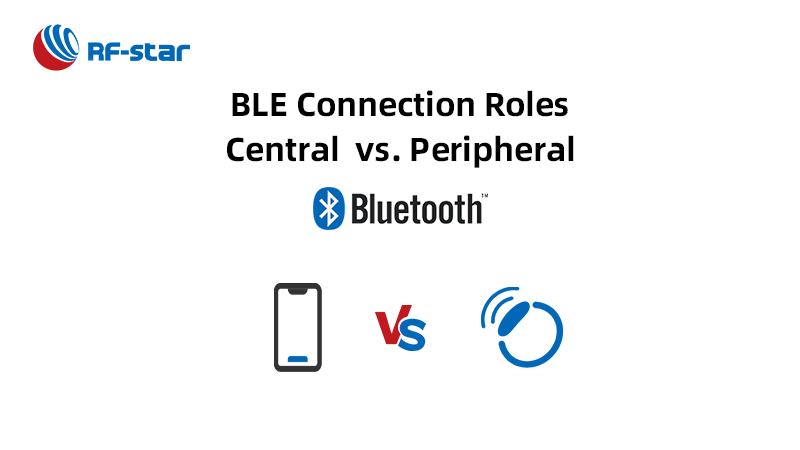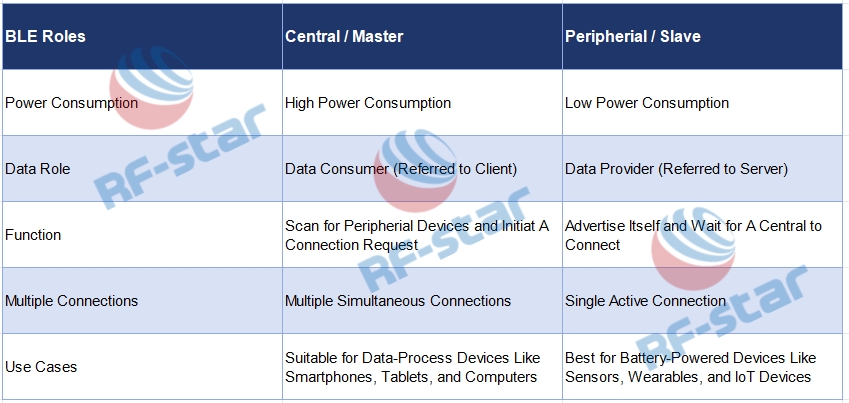In the world of Bluetooth Low Energy (BLE), BLE devices are designed to play specific roles that dictate how they interact within the BLE ecosystem. To fully leverage the benefits of BLE technology, it is essential to understand the roles of BLE devices in the communication process.

In this article, we introduce the common roles in BLE connection, the differences between Central and Peripheral roles, and how to choose well-suited BLE modules for your projects.
The two primary BLE roles are the Central and Peripheral roles.
The Central is a device with powerful and rich resources. The BLE central device initiates an outgoing connection request to an advertising peripheral device, and processes data provided by the peripheral. In a way, it can be regarded as the active role, also referred to as a “master”. A typical example of a central device is a smartphone, which can connect to several peripherals simultaneously, collecting, and processing data from each.
On the other hand, the Peripheral is a typically low-power, resource-constrained device that provides data. It accepts an incoming connection request after advertising its presence to other devices in the vicinity. Generally, the Peripheral is meant to stay put until someone decides to connect with it. Hence, it is also called a “slave”. A peripheral is usually a small device like a smartwatch, a temperature sensor, a heart rate monitor, etc.
The BLE specification does not limit the number of slaves a master may connect to, but there is always a practical limitation, especially on different models of modules. For instance, RF-star’s BLE modules based on TI CC2642R, CC2340, Silicon Labs EFR32BG22 and Nordic nRF52840 nRF52832 SoCs play a master and multi-slave roles. Support at most 8 simultaneous and stable connection devices, that is 7 slaves and 1 master. Furthermore, the EFR32BG22 and CC2340-based Bluetooth Low Energy modules can connect simultaneously to multiple masters and slave devices.
After knowing the definition of connection roles in BLE communication, let’s move to their distinction.
While BLE Peripherals and Centrals both contribute to BLE communication, they have unique features, capabilities, and requirements. Here is a table for you to clearly distinguish each other.

As the above shows, a Peripheral in BLE is a low-power device, mainly providing data. It wakes up only to advertise or transmit data while spending most of the time in a low-power sleep mode. A Central, in contrast, is power-hungry, continuously scanning for peripherals and managing multiple connections. Some Central devices, like smartphones, can maintain several connections simultaneously, making them suitable for data aggregation and processing, whereas peripherals are commonly found in battery-powered devices like sensors, wearables, and beacons.
Knowing these differences, is it clear how to choose between a master and slave role for your BLE device? Don’t worry! RF-star lists some useful suggestions for a better choice of your specific needs.
Fortunately, as diverse demands grow and BLE technology advances, more and more master-slave Bluetooth modules have emerged on the market. With their dual-role capability, these modules can reduce overall application costs and enhance usability, making project optimization easier.
Understanding the distinct roles of Central and Peripheral devices in BLE communication is crucial for maximizing project performance and efficiency. Factors such as energy efficiency, data role, multi-device connectivity, resource allocation, tailored application needs, scalability, ease of integration, and user interaction patterns should be carefully considered when choosing BLE modules.
Whether you're developing wearable technology, smart home devices, or industrial sensors, selecting the right BLE connection role can significantly impact your project's functionality and success. Keeping these considerations in mind as you embark on your BLE journey ensures your devices seamlessly connect and communicate in the ever-expanding world of Bluetooth Low Energy technology.